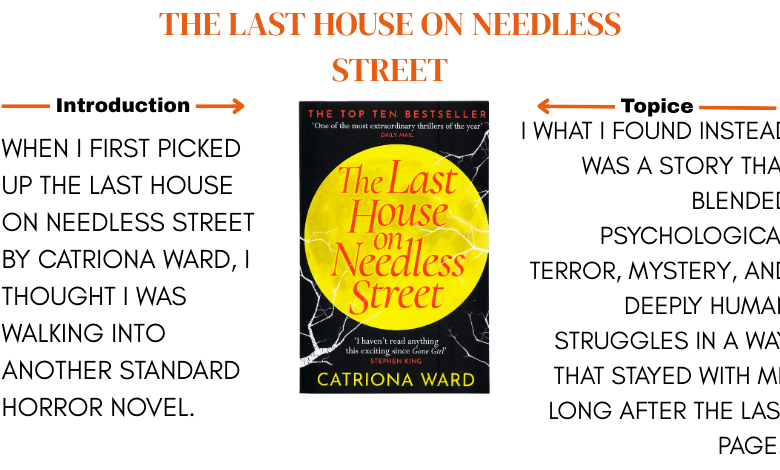The last house on needless street

When I first picked up The Last House on Needless Street by Catriona Ward, I thought I was walking into another standard horror novel. I couldn’t have been more wrong. What I found instead was a story that blended psychological terror, mystery, and deeply human struggles in a way that stayed with me long after the last page. This is not a book you can just read and put down. It’s the kind of novel that lingers, that makes you question memory, truth, and even the limits of your own perception.
In this article, I want to share not only the details of the book—its summary, themes, and characters—but also my personal reflections on why it hit me so hard. I’ll break down the twists, explore what makes Catriona Ward’s writing so unique, and even suggest other books you might enjoy if this one hooked you like it did me.
Overview of The Last House on Needless Street
At its heart, The Last House on Needless Street is a gothic psychological thriller that plays with perspective and memory. The story is told through multiple narrators, including Ted, a reclusive man living in a boarded-up house at the end of Needless Street; Olivia, his cat; Dee, a woman searching for her missing sister; and occasionally others.
Ted is a character you’re never quite sure how to feel about. On one page, he seems gentle, even pitiable. On the next, you question whether he might be capable of something horrifying. His home is both a fortress and a prison, a reflection of the mental and emotional barriers he carries.
Then there’s Olivia, the cat who narrates parts of the book with a strangely spiritual and philosophical tone. At first, her chapters threw me off—I thought, “Really, a cat narrator?” But soon I realized Olivia provides a lens into faith, morality, and judgment that no human character could deliver.
Dee, meanwhile, is consumed by grief and rage after her sister’s disappearance years ago. Her quest brings her to Ted’s door, where past and present collide.
The plot unfolds slowly, demanding patience from the reader. But that patience pays off with revelations that are both shocking and deeply moving.
The Writing Style of Catriona Ward
Ward writes with precision and restraint. She doesn’t rely on cheap scares or gore. Instead, she builds unease through fragmented memories, unreliable narrators, and shifting points of view. What I admire most is how she respects her readers. She trusts us to piece things together without spoon-feeding the answers.
I’ve read many thrillers that felt manipulative, where the author hid key details just to create a twist. Ward is different. She gives us all the pieces, but the way she arranges them makes us doubt our own conclusions. It’s clever without being gimmicky.
Read Also: Jamaican Jerk House: A Taste of Authentic Caribbean Flavor
Themes in the Book
This novel isn’t just about horror—it’s about survival.
Trauma and Memory:
So much of the story revolves around what we remember and what we block out. Ted’s memories are fractured, unreliable, and painful. As someone who has seen how trauma reshapes people in real life, I found these sections incredibly raw.
Family and Identity:
The book asks big questions about what makes a family. Is it blood? Care? Survival together? Lauren, Ted’s daughter, embodies this struggle, as do Dee’s desperate attempts to find her sister.
Faith and Redemption:
Olivia’s chapters dive into questions of sin, grace, and forgiveness. For a cat, she feels strangely human in her spiritual wrestling. I found myself underlining entire passages because they echoed questions I’ve asked myself.
The Role of Olivia the Cat
I’ll admit it—when I realized one of the narrators was a cat, I almost put the book down. But Olivia quickly won me over. She’s funny, surprisingly wise, and serves as a mirror for the human characters’ inner battles. In many ways, she represents an outside voice of conscience.
Her chapters reminded me of how pets often sense things about us that we can’t even admit to ourselves. If you’ve ever had a cat curl up next to you during a difficult moment, you know what I mean.
Ending Explained
Without spoiling too much, the ending of The Last House on Needless Street pulls the rug out from under you while also tying together every thread.
The truth about Ted’s identity and past changes everything you thought you knew. What seems like a simple case of a creepy man in a boarded house becomes a layered exploration of trauma and dissociation. The “twist” isn’t there just to shock you—it’s there to make you rethink the entire book.
For me, the last chapters were emotional. I wasn’t just surprised; I felt sorrow, relief, and even admiration for how Ward respected her characters enough to give them depth rather than turning them into horror stereotypes.
My Personal Thoughts and Reading Experience
I read this book late at night, and I’ll be honest—I had to put it down a few times. Not because it was too scary, but because it was emotionally heavy. Ward doesn’t just play with fear; she digs into pain, loss, and survival in a way that feels deeply personal.
One of the most haunting parts, for me, was how much the book made me reflect on real people I’ve known who live with trauma. It reminded me that we never fully know what others are carrying.
Reader Reception and Reviews
This book has received wide acclaim, and I can see why. Critics have praised it for originality, while readers on forums and book clubs often mention how it stayed with them for weeks after finishing. Some found it confusing at first, but nearly everyone agrees the payoff is worth it.
It has also won awards, including the British Fantasy Award, and cemented Catriona Ward’s reputation as one of the best modern horror writers.
Similar Books to Read Next
If you loved The Last House on Needless Street, you might enjoy:
-
Sundial by Catriona Ward (another layered psychological horror)
-
We Have Always Lived in the Castle by Shirley Jackson
-
Mexican Gothic by Silvia Moreno-Garcia
-
You Let Me In by Camilla Bruce
Each of these plays with unreliable narrators, eerie settings, and deep psychological tension.
Adaptation News
The book has already been optioned for a movie adaptation. While details are still limited, I can imagine how visually striking it could be if handled well. The challenge will be capturing Olivia’s voice and the fragmented perspective shifts without confusing viewers.
Conclusion
The Last House on Needless Street is not just a horror novel—it’s a meditation on memory, survival, and identity wrapped in the skin of a thriller. It’s unsettling, yes, but also deeply moving. For me, it was one of those rare books that didn’t just scare me but made me think about what it means to be human.
FAQs
1. Is The Last House on Needless Street really scary?
It’s unsettling rather than terrifying. It leans more on psychological tension than gore.
2. Is the cat really a narrator in the book?
Yes, Olivia the cat has entire chapters. Surprisingly, her voice adds depth and humor.
3. What is the main theme of the book?
The story explores trauma, memory, family, and identity, wrapped in a horror-thriller structure.
4. Who is the author?
Catriona Ward, a British writer known for modern gothic horror.
5. Will there be a movie?
The rights have been optioned, though production details are still limited.



